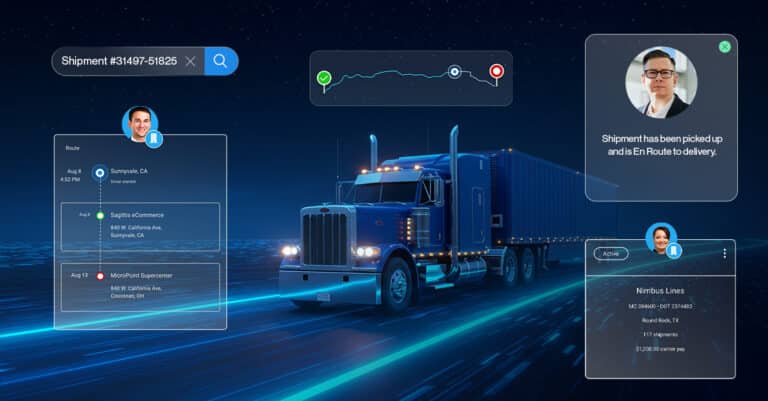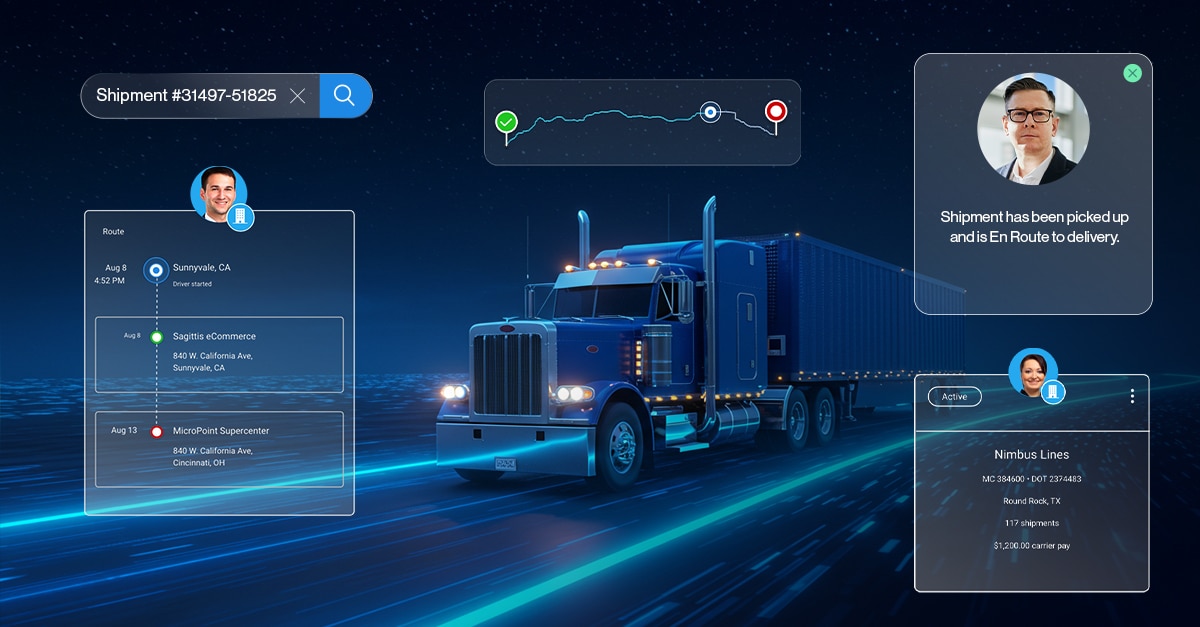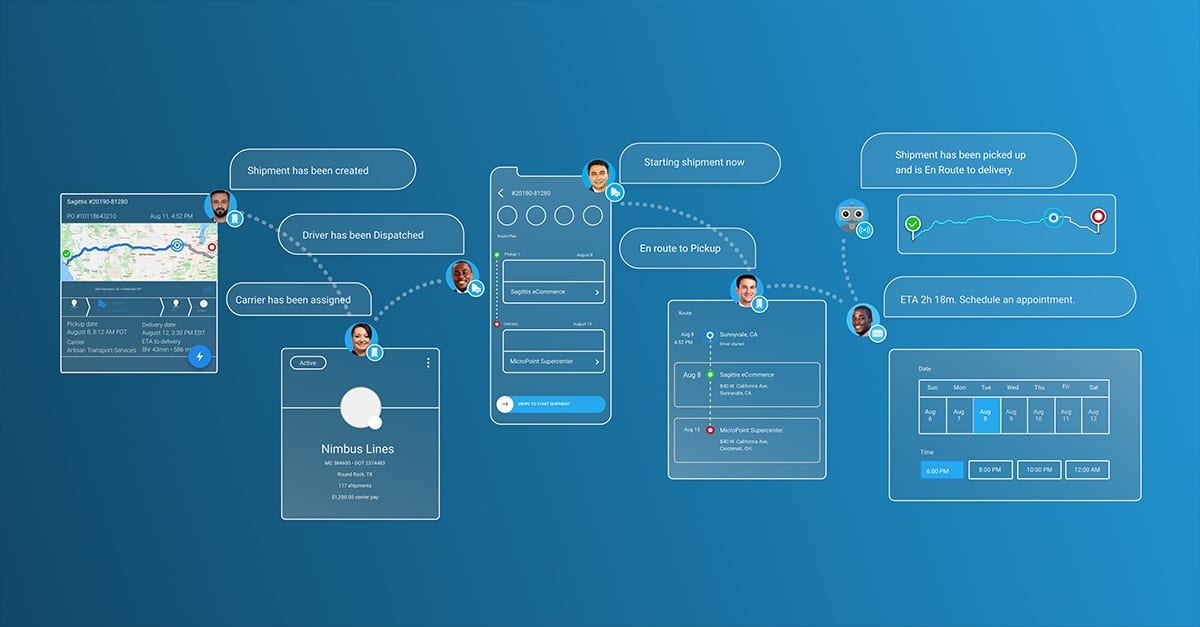TMS software has become an overall supply chain necessity. However, knowing the present and future needs of TMS is essential before making a large investment. TMS software should grow in parallel to the company it’s being used in.
The individual need is one of the most crucial parts of choosing the best TMS technology for overall corporate goals and client satisfaction. Utilizing real-time data that organizes multiple services seamlessly throughout a global network helps you serve clients seamlessly from the other side of the world, to down the street for a local delivery.
The complexity of today’s supply chains requires a new level of clarity and integration, only provided by cutting-edge TMS solutions. Today’s cutting-edge tech stacks give a much better view of the overall market and help companies stay ahead of the change curves, by providing real-time data about what’s happening at this moment, and what’s coming down the line.
What is TMS Software?
Transportation Management System (TMS) software is a valuable tool for supply chain management. It helps companies manage, optimize, and track transport activities. TMS software streamlines processes such as carrier selection, freight audit and payment, route planning, and more.
With the growth of global trade and the increasing complexity of supply chains, TMS automates freight management tasks using algorithms that factor in variables such as fuel efficiency and delivery time. The benefits to implementing TMS include increased efficiency in transportation operations, reduced lead times on shipments, and better utilization of assets that lead to cost savings for businesses.
Furthermore, cutting-edge technology such as artificial intelligence and machine learning allows for more precise forecasting and improved analytical capabilities to manage freight transport data.
The Importance of TMS Technology for Supply Chain Management
The role of TMS is critical in today’s global trade environment. TMS software streamlines logistics and provides real-time visibility and control over the movement of goods.
TMS enhances tracking capabilities and provides valuable information on delivery timelines, bottlenecks, and the status of shipments. It reduces operational costs by optimizing routes, consolidating shipments, and minimizing delays.
It also enables flexible decision-making by allowing alterations to be made quickly in response to volatile market conditions or unforeseen events. Choosing the right TMS provides greater job satisfaction for staff, eliminates operational inefficiencies, and reduces costs significantly.
In a competitive business environment, companies need to respond dynamically to change and stay ahead of the curve. Therefore, TMS systems are an integral part of an organization’s supply chain strategy. With a tech approach, businesses upsurge profitability by planning better transportation processes while improving customer satisfaction rates.
Key Considerations for Choosing TMS Software
When selecting a TMS, take these key considerations into account.
Identify Your Business Needs and TMS Requirements
Before selecting a TMS solution, businesses should evaluate their specific needs and requirements. Factors such as the size and scope of operations, the number of carriers and suppliers, and the complexity of the supply chain network should be considered. Your choice of software should meet your business demands and increase efficiency rather than cause unnecessary problems.
If you plan to expand your business or operate in new locations, then it’s important to choose enterprise-level TMS with comprehensive financial and analytical tools, and integrations that help streamline shipments across different channels.
Also, you need to look into the challenges experienced in your supply chain logistics such as scheduling pick-ups, freight optimization, route planning and delivery tracking, and compliance requirements (customs and regulations), among others.
Once you identify these needs, it’s easier to understand the features required for your TMS software. Evaluating your needs helps ensure the right technology implementation, which results in increased profitability and efficient supply chain management.
Assess the Size and Complexity of Your Supply Chain Operations
TMS solutions are designed to cater to different business sizes and supply chain complexities. Companies should evaluate transport requirements and select a TMS system that aligns with their operational needs. Some TMS solutions may focus on specific transport modes or regions, while others offer broader functionality.
The size of your supply chain can be determined by identifying all the individuals, departments, and organizations that are involved in the flow of goods and services from your suppliers to your customers.
The complexity of your supply chain involves several factors such as the number of participants, geographic locations, modes of transportation used (ocean, air, etc.), customs regulations, language barriers, technology platforms used for communication, and data exchange, etc.
Understanding these factors supports decision-making processes related to product sourcing or delivery models. It’s crucial to establish efficient communication channels with all parties involved in the supply chain while utilizing technologies that streamline operations and mitigate possible issues. Enhancing transparency among working partners improves overall quality control measures and leads toward sustainable business practices.
Decide Whether the TMS You Choose is a Tool or a Chore
One of the most important considerations, you should ask yourself and your team if your selected TMS is working as a tool for the team, or if it feels more like a chore. When any operating system becomes a chore for teams to use, they tend to be used less effectively than intended, rendering a beautifully sophisticated system almost useless. This causes more manual work and reduces efficiency, which is the exact opposite of why companies invest in TMS in the first place.
The needs of every company differ; the main management parts all operate similarly, and some of the reporting is common across the board. However, the smaller components or modules of a TMS matter the most and help serve clients at higher levels, complete tasks faster, help teams collaborate with ease, and achieve goals more quickly.
These small but critical parts of TMS help the overall function and useability of the system and turn its use from a chore to a tool. This helps achieve more significant results in less time, frees up human resources, and even alleviates costs.
P.S. Learn how Port City Logistics utilizes the various smaller components of Turvo to bring massive 3PL growth and moves toward 4PL status.
Evaluating TMS Features and Functionalities
Evaluating key TMS features requires a thorough analysis of business requirements, current logistical operations, and technology capabilities. Here are some of the core TMS functionalities and their benefits.
Transportation planning and optimization
Planning and optimization features allow businesses to plan and optimize their transportation routes, reduce costs and improve efficiency. This technology enables businesses to plan routes, manage loads, track shipments in real time, and reduce fuel consumption while improving delivery times.
The TMS platform optimizes routes based on real-time data feeds from weather reports or traffic congestion data to ensure that deliveries are made efficiently, without delay or loss of goods.
With a focus on sustainability, TMS systems promote the use of less carbon-intensive vehicles like electric cars, bicycles, or electric scooters which significantly decreases greenhouse gas emissions.
Real-Time Visibility and Collaboration
Greater transparency enables businesses to effectively manage their supply chains. With the ability to track shipments in real time, companies quickly identify potential delays or issues and take appropriate action before they become bigger problems.
A good TMS dashboard displays real-time shipment tracking and other collaborative features for the team to easily access with minimal clicks.
This allows for better communication and collaboration between stakeholders involved in the supply chain and allows them to work together more efficiently and effectively to ensure timely delivery of goods.
Additionally, TMS provides detailed analytics that helps businesses make data-driven decisions based on actual performance data. The TMS platform also offers customizable alerts and notifications, enabling users to stay up-to-date on critical information in real time.
Managing Exceptions
Managing exceptions refers to the process and technology used to identify and address any unexpected events or issues that arise during transportation operations.
In other words, exception management is a strategy designed to help businesses proactively manage potential disruptions in their supply chain by keeping track of real-time data that affect the delivery of goods.
These exceptions may include delays, missed pickups, route changes, or any other unforeseen circumstances that could impact shipping schedules. A TMS system with built-in capabilities to manage exceptions allows companies to quickly respond to these issues and minimizes the potential impact on customer service levels while ensuring efficient and timely deliveries.
Rick Grubb II, Chief Information Officer, North America & Europe
“95 percent of our shipments go off without a hitch. They should go through the system from point A to B without a problem. But it’s the 5 percent we need to know what happened, how do we treat the exception. Turvo helps bring transparency so operators can find the problem, fix it, and communicate.”
Read the full case study of our vehicle and specialized freight broker client.
TMS Software Integration Capabilities
It’s no surprise that a TMS needs to be integrated with other technologies to function optimally. When on the hunt for the best TMS software, you need to ensure that it has robust integration capabilities and modern, open APIs which allow technologies to talk to each other
Integration with Other Supply Chain Technologies
The best TMS system should integrate smoothly with various supply chain technologies, including warehouse management systems (WMS), electronic data interchange (EDI), and transportation forecast systems. This helps to streamline your entire logistics process and ensure that your shipments are delivered promptly.
Compatibility with Existing Enterprise Resource Planning (ERP) Systems
Another vital aspect to consider when selecting TMS is its compatibility with your existing ERP systems. A TMS system that can’t integrate with your ERP software leads to data inconsistencies, which is costly for your business. Therefore, assess the compatibility of the TMS with your existing ERP software before making a final decision.
Turning A TMS System Into A Tool
The most incredible miss by TMS creators is user challenges. It was once said in the software world that if garbage goes in, garbage comes out. This remains true for any TMS software not set up to help companies with specific goals and functions to help their team and clients excel.
Using the TMS system to help achieve goals faster, produce more revenue, and connect teams globally, starts with an extreme focus on user ease and short learning curves to get up and running on the system as fast as possible. When TMS systems miss the mark on client ease of use, they lose the overall battle of client satisfaction.
So it’s critical to turn your TMS into a tool your team can use to become more productive while easing the learning curve. Working through these small factors helps make the right software choice to grow with the system instead of against it.
Examining TMS User Experience and Support
Before purchasing TMS software, you should also consider the user experience and support provided by the vendor.
User Interface and Ease of Use
A good TMS should have an intuitive user interface that is easy to navigate. This ensures that your employees use the software seamlessly, thereby reducing the risk of errors and increasing efficiency.
P.S. Check out our ‘Six Keys to Accelerated Growth with Modern TMS’, which also covers the importance of a TMS’s intuitive UI to business growth.
Vendor Support and Training Resources
It’s important to choose a TMS vendor that offers reliable support and training resources. A vendor who provides regular software updates, helpful resources, and prompt customer service helps you get the most out of your TMS investment.
Why You Should Opt for Cloud-Based TMS
One of the primary reasons businesses should opt for cloud-based TMS is its flexibility and scalability. Cloud-based TMS allows companies to quickly implement new features and functionality without requiring hardware investments or software updates.
Additionally, cloud-based TMS enables businesses to access their transportation data from any location or device and makes it easier to collaborate with partners and stakeholders in real time.
Cloud-based TMS also provides enhanced data security protocols and disaster recovery capacities and ensures that critical transportation data remains protected in the event of an unexpected outage or emergency.
Ultimately, a cloud-based solution improves TMS tracking and reduces costs associated with IT maintenance and infrastructure upgrades.
The Implications of Free TMS Options and Why You Should Avoid Them
While paid TMS solutions offer robust features, the availability of free alternatives expands accessibility to technology that was previously out of reach for smaller companies or independent operators.
However, these free software options often lack deeper functionality and customizability, potentially limiting their usefulness for more complex supply chain management tasks.
Additionally, businesses should be mindful of any potential hidden costs that may come with a free TMS solution, such as limited scalability or less comprehensive customer support.
Overall, businesses should carefully consider their specific needs and budgetary constraints when deciding whether to pursue a free TMS option or invest in a more robust paid solution.
Invest In Future Growth
Choosing the perfect TMS software is a long-term decision that must grow with the company and teams. Some systems help companies reach a specific business milestone. However, a good number of TMS platforms plateau and leave companies looking for new solutions when they hit a specific employee count, sales growth, service expansion, etc.
It’s key to invest in a TMS that grows with a company’s needs. Modular systems that allow logistics firms to choose a level of value could act as the growth stages and enable companies or teams to reduce learning curves and ongoing frustration with switching systems.
Like all TMS technology, it’s an investment into your market value and is made to add to overall growth, not stagnate it. So choosing a system that is not or can not integrate into long-term business plans is a disaster waiting to happen and usually hits at the worst time.
Modular tech stacks act as supporting functions to your growth and allow you to grow into the complete services of a TMS system. These functions, depending on your company’s market direction, include but are not limited to:
- Operations
- Sales
- Pipelines and upcoming revenue
- Loaded vs empty miles
- Client state grouping
- Instant data
- Robust to-the-point reporting
- User functionality
- New employee training, time to get up to speed
…and a host of other points must be considered.
All these functions must be client-centric and ready to be upgraded as you scale your business, leaving no stone unturned and every T crossed.
Collaboration is in Turvo’s DNA with a complete integration suite, and the platform brings people, systems, and technologies together. This is the ultimate power of TMS software; this is also where Turvo shines. With Turvo’s tech stack, modular options, and unlimited scaling ability, you’re in good hands for every level of growth and client success you’re after.








